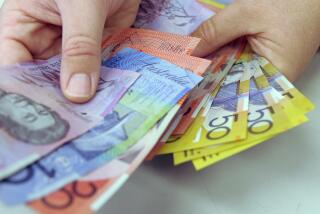New and Improved, but Still $50
- Share via
WASHINGTON — The Treasury Department unveiled a new $50 bill Thursday, its latest effort to prevent counterfeiting and a move to help people with poor eyesight.
The unveiling came 16 months after introduction of a new $100 note and will be followed by redesigned $20 bills next year. Other currency denominations--the $10, $5 and $1 bills--will be revamped later.
The new currency replaces the $50 bill design in use since 1929.
For most people, the most visible difference is an enlarged, off-center portrait of President Ulysses S. Grant on the front and the large 50 in the bottom right-hand corner on the back.
The engraving of the Capitol on the back has also been enlarged to include more detail and reflect a contemporary view of the building’s west front.
The bill is packed with high-tech features designed to thwart counterfeiters from using advanced technologies such as color copiers, scanners and printers to produce near-duplicates.
“With this redesign, government demonstrates its ability to stay ahead of the technology curve,” Treasury Secretary Robert E. Rubin said in an unveiling ceremony at the Bureau of Engraving and Printing.
The Secret Service says it has identified counterfeit versions of $100 bills only one-eighteenth as often with the remade bills as it did with the old series. The new notes represent a third of the $100 bills in circulation.
Like the introduction of the redesigned $100 notes, the new $50 bills will replace the older series gradually. The older bills will be replaced as they reach the Federal Reserve from depository institutions.
About $46.5 billion in $50 bills are in circulation.
Both Rubin and Federal Reserve Board Chairman Alan Greenspan emphasized that the older bills remain legal tender. They said existing notes will not be recalled or devalued.
The Treasury Department said that when the smaller bills are redesigned, they too will bear a large denomination number, as will future redesigns of the $100 note.
High-tech anti-counterfeiting features include:
* A watermark to the right of Grant’s portrait, visible only when the bill is held up to light.
* A security thread to the right of the portrait that glows yellow when exposed to ultraviolet light. “USA FIFTY” and a flag, which contains microprinting, are printed on the thread.
* Color-shifting ink in the numeral in the lower right-hand corner of the bill front that changes from green to black when viewed from different angles.
* Microprinting in the border and in Grant’s shirt collar.
* Concentric fine-line printing in the background of the portrait and on the back of the note.
The Treasury Department said more than 3.7 million Americans have visual disabilities and that as many as 10 million have milder forms of visual impairment.
“The bigger, bolder numerals will be helpful to millions of young Americans born with impaired vision and adults who lose vision in later life--as well as all those people who don’t always wear their glasses,” said Patricia M. Beattie, first vice president of the Council of Citizens With Low Vision International.
More to Read
Sign up for Essential California
The most important California stories and recommendations in your inbox every morning.
You may occasionally receive promotional content from the Los Angeles Times.









